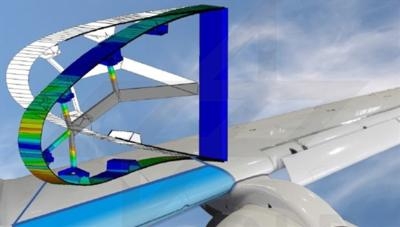Mon, Sep 10, 2012
Aircraft With No Leading-Edge Slats Will Be Quieter And More Environment-Friendly
In a effort to make air travel quieter and more environment-friendly, researchers at the German Aerospace Center (Deutsches Zentrum für Luft- und Raumfahrt; DLR), together with partners Airbus, EADS Innovation Works and Cassidian Air Systems, have been carrying out research to reduce the aerodynamic drag of aircraft. A recent result of that research is the development an alternative to the traditional leading-edge slat.

A morphing leading edge is expected to replace slats to create an innovative high-lift system. The testing data shows that the configuration should significantly reduce drag and noise during landing. Tests were carried out between August 27 and September 7 in one of Europe's largest wind tunnels at the Russian Central Aerohydrodynamics Institute’s (TsAGI) Zhukovsky research facility south of Moscow.
In the wind tunnel, the system's operation and performance were tested under realistic conditions. "The measurements on the droop nose here at TsAGI are just one example of the exceptional collaboration between DLR and TsAGI. We are looking forward to future cooperation," said Sergey L. Chernyshev, Executive Director of TsAGI. Normally, the flaps on the trailing edges of the wings and the slats located on the leading edges are extended during take-off and landing to provide the necessary lift at low speeds. There is a gap between the wings and the slats, through which air can flow from the underside of the wing to the top – generating noise. With the development of the smart droop nose, a morphing wing leading edge, the researchers have solved this problem. "The smart droop nose morphs itself during take-off and landing in such a way that no separate slats are necessary. The leading edge can be lowered by up to 20 degrees with virtually no loss of lift," explains DLR project leader Markus Kintscher
from the DLR Institute of Composite Structures and Adaptive Systems in Braunschweig.
The researchers also want to minimize drag to reduce fuel consumption. To accomplish this, the wing surfaces have been made as flat as possible to achieve laminar airflow. This reduces the air resistance by up to 12 percent. "The particular challenge in this project was to unite conflicting requirements," explains DLR Department Head Hans-Peter Monner. "On the one hand, the structure needs to be very elastic, to enable it to morph to the required shapes, but on the other it has to be very rigid. Ultimately, the leading edge must bear around one third of the weight of the aircraft during landing." A suitable material was required to ensure that the leading edge of the wing is not too heavy. During their experiments, the researchers concentrated on the glass- and carbon-fiber reinforced composites that are typically used in the aviation industry. A glass-fiber reinforced material turned out to be the most suitable for meeting the requirements.
In the concept of the droop nose, the skin on the front edge of the wing is just curved, not stretched. This stresses the material as little as possible. The scientists position individual layers one on top of the other, in such a way that the skin creates a structure that has a customised rigidity distribution. The leading edge morphs into the desired shape via integrated actuators and support elements along the wingspan, thus achieving very high stability. Soon, the new wing leading edge will be further developed to meet industrial requirements such as lightning protection, de-icing and the ability to withstand bird strikes.
(Image provided by DLR)
More News
From 2021: The Inside Skinny On What Being An ANN Oshkosh Stringer Is All About By ANN Senior Stringer Extraordinare, Gene Yarbrough The annual gathering at Oshkosh is a right of p>[...]
Video Showed That During The Takeoff, The Nose Baggage Door Was Open On May 10, 2025, about 0935 eastern daylight time, a Piper PA-32RT-300, N30689, was destroyed when it was invol>[...]
Get The Latest in Aviation News NOW on Instagram Are you on Instagram yet? It's been around for a few years, quietly picking up traction mostly thanks to everybody's new obsession >[...]
"I think what is key, we have offered a bonus to air traffic controllers who are eligible to retire. We are going to pay them a 20% bonus on their salary to stay longer. Don't reti>[...]
Aero Linx: Pilot Briefing The gathering, translation, interpretation, and summarization of weather and aeronautical information into a form usable by the pilot or flight supervisor>[...]
 Oshkosh Memories: An Aero-News Stringer Perspective
Oshkosh Memories: An Aero-News Stringer Perspective NTSB Prelim: Piper PA32RT
NTSB Prelim: Piper PA32RT ANN FAQ: Follow Us On Instagram!
ANN FAQ: Follow Us On Instagram! Aero-News: Quote of the Day (05.28.25)
Aero-News: Quote of the Day (05.28.25) ANN's Daily Aero-Term (05.28.25): Pilot Briefing
ANN's Daily Aero-Term (05.28.25): Pilot Briefing



